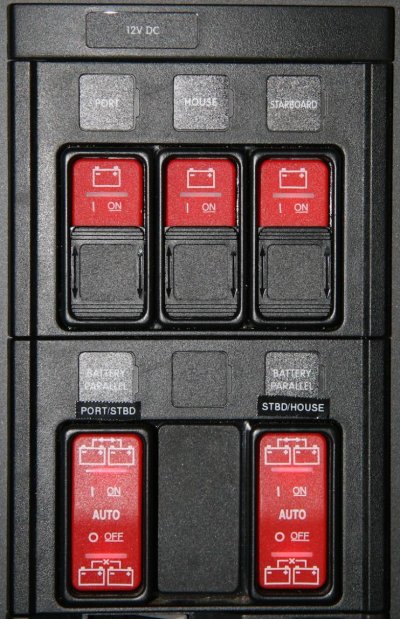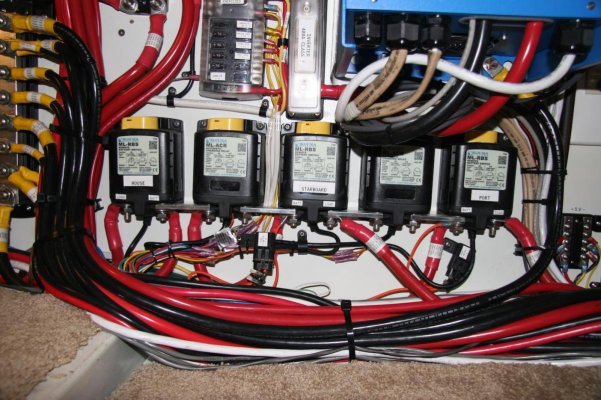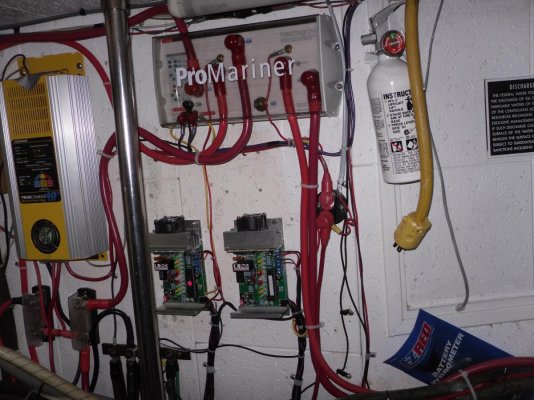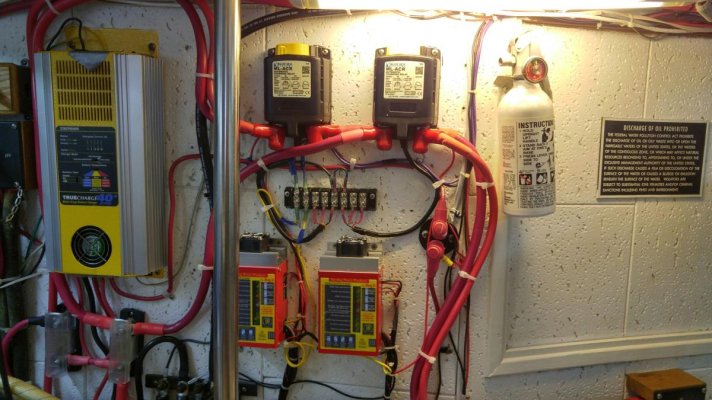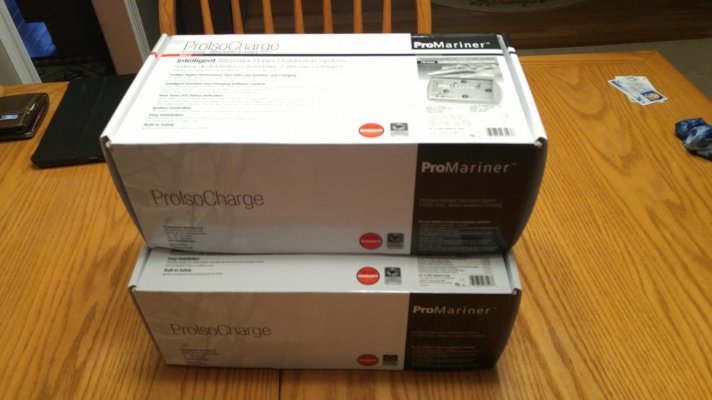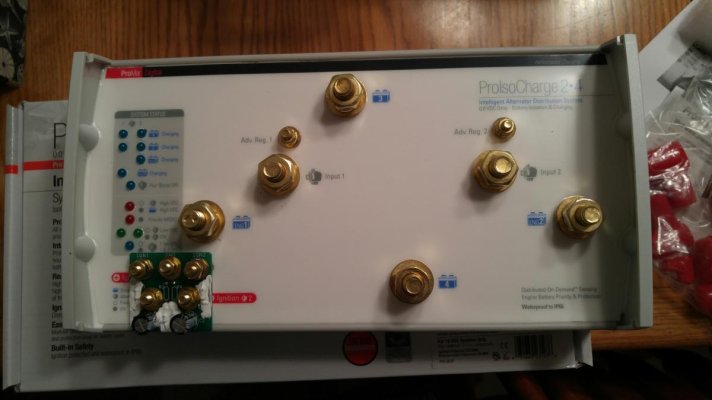Here's a link to a
Sailing Today comparison of many isolator - combiner technologies.
I rewired my charging system and considered a Blue Sea unit but finally decided on a Sterling CVSR that I purchased from CMS.
My situation was a somewhat unique one and was the reason for deciding against the Blue Sea.
See this link for detail of my system if interested.
Sadly the information in that article appears to be written by someone reading glossy marketing material rather than having a solid grasp of charging systems? Of course most magazines won't devote the space necessary to write an article like that for how it really needs to be written so we get incomplete articles that lack a lot of detail.
A few thoughts, and I do remember selling a CVSR to Ken whom I am assuming is your brother..?
One of your biggest limiting factors aboard Bacchus is your LR-180-03 alternator. Those Deka's really, really, really don't like PSOC cycling and need to see proper absorption voltages, 14.6V ideally for upwards of 5+ hours from 50% DOD. Unfortunately our LR-180-03 is simply not capable of this due to the thermistor protection and voltage fold back gradient built into it (automotive alt).. A conversion to external regulation then dialing it back to about 45-50A would be the best case scenario and actually yield a healthier charge profile.
In situations like yours I will almost always feed the alt directly to the house bank. This allows for proper voltage sensing and optimal charge performance in the shortest time frame, though the house bank would ideally be contiguously wired..
You can't adequately & accurately voltage sense the battery with a 1/2/BOTH switch in the path and there is always performance robbing voltage drop in that path. The closest you can get is the "C" post but if this is closer to the banks then it is better than nothing (sensing at the alt)..
By leading the charge to house you can then use a smaller ACR or even an Echo charger for a
start battery, which I did not see on your diagram.
The point in the article about VSR's chattering and combining & un-combining (called relay cycling) is simply the result of an improperly installed VSR. By feeding all charge current to house you prevent relay cycling all together by passing only the current necessary to charge the lightly discharge start battery. It takes very, very little Ah capacity to start an engine.
This is the number one issue I see with VSR relays an improper installation by feeding charge first to a small lightly discharged start bank and then combining with a large deeply discharged house bank. This not only leads to relay cycling, especially with solar and wind, but also forces all alternator current to pass through the relay. By wiring to house first only the low current needed to charge the start battery runs through the VSR.
I will quite often place an ML-ACR with dash switch between house and thruster banks. Some of the thrusters I work on are 400A at 12V.

Not my idea BTW......
By having the ability to lock the relay into combine/parallel mode you now pick up extra oomph from the house bank plus you have the alternator output to feed the thruster and it is not current limited with the ML-ACR. In your situation you're not gaining much from the alt but any little bit helps.
We have some marinas up this way with serious river or tidal current and even an 8D at 400A does not hold voltage for very long, and yield peak performance, if the owner is heavy on the thruster. The ML-ACR is capable of passing 500A continuously thus does not need the current limiting Charlie built into the CVSR. I have owners with massive high performance alternators and when the ML switch is activated, paralleling the house bank and bow bank, plus picking up the alt boost, the thruster performance is alarmingly improved.
Some of the big engines have pre-heaters that draw significant current (some over 200A) and so in some cases I will leave the alt feeding start and use an ML-ACR that can be manually locked at the dash to prevent relay drop out due to the pre-heater sucking start bank voltage down. In your case it appears you use house for start and hotel loads so feeding the alt direct to house with external regulation would certainly be a charge performance improvement. All this depends on how much time away from the dock you spend. If you weekend jaunt only then the Hitachi as is can suffice. If you cruiser for more than a few days at a time converting it to external regulation would be a good choice. If you cruise heavily then a larger alt would be an even better choice. Some of the 6LP's already have dual v-belts..
The Hitachi LR-180-03 is a bit tedious to convert to external regulation but it can be done. I usually keep a few of them on-hand (already converted) because they are such poor performing factory alts, and many owners don't want to pony up for a beefier alt, but they want the ability to attain a healthy absorption voltage for their expensive batteries.
The CVSR is a neat piece of gear that allows Charlie to use smaller capacity relays, if you have the ability to push more than 2X the current across it. If you are not grossly exceeding the capability of the CVSR then the thermal fuses don't ever really come into play.
Any VSR will drop out when voltage drops below combine threshold (provided time limits are met), as happens with thruster banks, so unless you have an alt capable of more than the relay can pass you won't damage it by pulling lots of current from a thruster bank it will just un-combine on low voltage.
The other point that is critical for bow banks, if you have alternative energy, is the ability to recharge via solar. When charge management is connected to an ignition feed this ability is lost and you will only get back to 100% dock side or when under power for many, many hours. I have this exact issue on my own boat, with my emergency/reserve bank which is charged via a Balmar Duo Charger excited by ignition. In this application it works fine because the self discharge rate is such that this is a non issue in the application..
The good news is there is no right or wrong way just lots to consider. Some products have proven less reliable than others and the Blue Sea relays (Yandina too) for me have proven the most robust and bullet proof. Sterling's are good too but not all models are s reliable as others.


